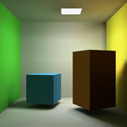This computer-generated rendering represents aspects of the natural phenomena of radiosity: “When a surface has a reflective light component, it not only shows up in this image, it also shines light at surfaces in its neighbourhood. And vice-versa. In fact, light bounces around in an environment until all light energy is absorbed (or has escaped!).” From Blender, a free open source 3D content creation suite, documentation.
NSDL partner the Exploratorium features representations of museum exhibits in their digital library. Online visitors are advised, “These versions in most cases are not adequate replacements for the real experiences that you will have if you are able to visit us.” Seeing is believing when it comes to experiencing the real world. Linking that experience to teaching and learning is what Chad Dorsey, Science and Educational Technology Specialist at the Maine Mathematics and Science Alliance, will explain to teachers on June 19, 2007. Register here for the free upcoming NSDL/NSTA Web Seminar entitled Using Digital Phenomena and Representations to find out how to use real-life phenomena to explain the natural world to 6-9 grade students aligned to learning benchmarks and instructional criteria.
in their digital library. Online visitors are advised, “These versions in most cases are not adequate replacements for the real experiences that you will have if you are able to visit us.” Seeing is believing when it comes to experiencing the real world. Linking that experience to teaching and learning is what Chad Dorsey, Science and Educational Technology Specialist at the Maine Mathematics and Science Alliance, will explain to teachers on June 19, 2007. Register here for the free upcoming NSDL/NSTA Web Seminar entitled Using Digital Phenomena and Representations to find out how to use real-life phenomena to explain the natural world to 6-9 grade students aligned to learning benchmarks and instructional criteria.
Resources for the seminar will be from the NSF-funded NSDL PRISMS Project. PRISMS has built a collection of reviewed online phenomena and representations that have been analyzed and annotated by reviewers using content alignment and instructional quality criteria based on the AAAS/Project 2061 Curriculum Materials Evaluation.
The seminar is designed for educators of grades 6-9,including pre-service teachers, science education specialists, and curriculum developers.



Leave a Comment
* You can follow any responses to this entry through the RSS 2.0 feed.